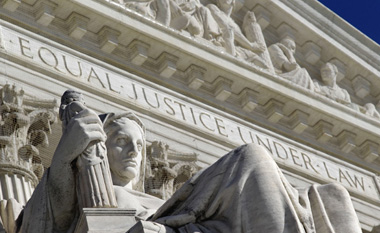The Supreme Court’s Review of the Affordable Care Act
Q&A with Associate Professor of Public Health Wendy Weller
 |
|
The Supreme Court's decision on the Affordable Care Act will have broad implications on the future of the U.S. health care system, according to UAlbany Associate Professor Wendy Weller.
|
ALBANY, N.Y. (March 23, 2012) -- On March 26, The Supreme Court of the United States is scheduled to begin hearing oral arguments regarding the Patient Protection and Affordable Care Act (PPACA).
The Court is weighing arguments on two specific parts of the legislation: The individual mandate and the expansion of Medicaid. The Court is expected to issue its written opinion by June 2012, although there is no set timeframe for the Court to act. The outcome is likely to have broad implications on the future of the U.S. health care system as well as the presidential election in November 2012.
UAlbany Associate Professor of Public Health Wendy Weller teaches courses on the health care system and health policy. She conducts research on improving access to care among the chronically ill, provider payment, and outcomes of surgical care.
Here is Weller’s insight regarding the legislation:
Q: What is the Supreme Court actually weighing?
A: The Supreme Court will consider the constitutionality of two major provisions of the Affordable Care Act (ACA): The individual mandate and Medicaid expansion. Although challenges to the individual mandate have received the most attention, the expansion of Medicaid is also a key mechanism of the ACA for covering the uninsured.
Q: What are the arguments for, or against, the ‘Individual Mandate?’
A: The Supreme Court will be considering if the individual mandate is within Congress’s power to regulate interstate commerce. The plaintiffs argue that the decision to not purchase health insurance amounts to an “inactivity” and therefore falls outside of Congress’s power to regulate interstate commerce. They also argue that the mandate forces people to purchase insurance, which is an unprecedented use of Congress’s commerce power.
 |
|
Associate Professor of Health Policy Wendy Weller
|
The federal government counters that Congress has the right to require people to buy insurance because health events are unpredictable. The cost to treat the uninsured results in higher taxes and insurance premiums for the insured which can pose a substantial burden on interstate commerce. The individual mandate tries to ensure that people don’t wait until they get sick to try to purchase health insurance. Also, by including both the healthy and sick in the insurance pool, the mandate makes other insurance reforms in the ACA feasible (e.g., coverage for people with pre-existing conditions).
Without the mandate, people who consider themselves healthy may not enroll in insurance, leaving insurers with a large pool of people who are sicker than average. This is referred to as adverse selection. Premiums will increase substantially in order to cover the higher costs of enrollees, making insurance less affordable for all. The federal government also argues that the individual mandate is a valid use of Congress to enact laws that are “necessary and proper” for executing its enumerated powers.
Importantly, the Court has also agreed to consider if the mandate is “severable” from the rest of the ACA; can the other parts of the ACA be upheld even if the individual mandate is struck down?
Q: What about the Medicaid expansion?
A: At issue with the Medicaid expansion is whether the ACA Medicaid expansion requirements unconstitutionally “coerce” states to expand Medicaid in order not to lose federal dollars. The ACA requires state Medicaid plans to cover all individuals under age 65 with individual or family incomes up to 133 percent of the federal poverty level starting in 2014. This represents a major change in the Medicaid program. Historically, most non-disabled, childless adults have been excluded by Medicaid, no matter how low their income. States must comply with this ACA Medicaid expansion or risk losing all federal Medicaid funding. The federal government will cover 100 percent of the states’ costs of the Medicaid expansion in the first two years and gradually decrease its contributions to 90 percent in 2020 and thereafter.
Q: What are the potential outcomes for PPACA?
A: No one knows for sure how the Court will rule. At one end of the spectrum, the Court could strike down the entire ACA. This would require both the federal government and states to reconsider ways of reforming the health care system, with states potentially assuming a larger role. On the other hand, the entire law could be upheld and states and the federal government will have to work together to implement the law. There is also the possibility that the Court will uphold some parts of the ACA, such as the Medicaid expansion, while striking down others, such as the mandate.
Q: What role will the outcome of the Presidential Election in November play on PPACA moving forward?
A: The outcome of the ACA depends not only on the Supreme Court’s ruling, but also on the results of the upcoming Presidential and Congressional elections. A number of bills to repeal the ACA have been introduced into both the House and Senate. The Republican-controlled House approved a bill to repeal the ACA, but a repeal bill was never passed by the Democrat-controlled Senate and President Obama has threatened to veto any repeal of the ACA.
The future of the ACA could change significantly if President Obama is not re-elected and if both houses of Congress end-up controlled by Republicans. Republican presidential candidates are united in their strong opposition of the ACA and have promised to repeal the law if elected, ultimately dependent on the Supreme Court ruling.
Whether or not a new Republican president could accomplish this will depend on who controls Congress. Even if the Republicans take control of the Senate and retain control of the House, they would need to have 60 votes in the Senate to be sure that they could override a filibuster. There is also the problem that some popular benefits of the ACA are already in effect, such as allowing children to stay on their parents’ insurance up to the age of 26. This may make it more difficult to roll back the entire law.
![]() For more news, subscribe to UAlbany's RSS headline feeds
For more news, subscribe to UAlbany's RSS headline feeds
Educationally and culturally, the University at Albany-SUNY puts "The World Within Reach" for its 17,500 students. An internationally recognized research university with 50 undergraduate majors and 125 graduate degree programs, UAlbany is a leader among all New York State colleges and universities in such diverse fields as public policy, nanotechnology and criminal justice. With a curriculum enhanced by 300 study-abroad opportunities, UAlbany launches great careers. For more information about this globally ranked University, visit https://www.albany.edu/. For UAlbany's extensive roster of faculty experts, visit www.albany.edu/news/experts.shtml.




